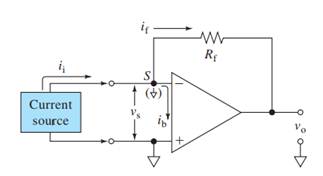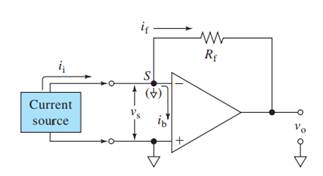
Concept explainers
(a)
Interpretation:
Current follower that will produce a 1.0 V output for 10.0 µA input current should be designed.
Concept introduction:
Operational amplifiers can be used to measure or process currents by connecting them in the current follower mode. This mode provides a nearly zero resistance load to the current source and prevents it from being loaded by a measuring device or circuit.

Here,
V+, V- = input voltages
Vs = Input difference voltage
V0 = output voltage
ib = input bias current
if = feedback current
ii = input current
Rf = feedback resistor
Also,
(b)
Interpretation:
Effective input resistance of the current follower designed in part (a) should be calculated.
Concept introduction:

Here,
V+, V- = input voltages
Vs = Input difference voltage
V0 = output voltage
ib = input bias current
if = feedback current
ii = input current
Rf = feedback resistor
Ri = effective input resistance
A = open loop gain
Also,
(c)
Interpretation:
The percent relative error for the circuit designed in part (a) for an input current of 25 µA should be calculated.
Concept introduction:

Here,
V+, V- = input voltages
Vs = Input difference voltage
V0 = output voltage
ib = input bias current
if = feedback current
ii = input current
Rf = feedback resistor
Ri = effective input resistance
A = open loop gain
Here,
Also,
Thus,
Relative error percentage =
Want to see the full answer?
Check out a sample textbook solution
Chapter 3 Solutions
Principles of Instrumental Analysis
- Determine the unknown (Abs=0.812) if the absorption of the standard are the following: Standard 1, Abs = 0.354 Standard 2, Abs = 0.453 Standard 3, Abs = 0.563 Standard 4, Abs = 0.683 Blank, Abs = 0.011arrow_forwardThe Weibull distribution is widely used in statistical problems relating to aging of solid insulating materials subjected to aging and stress. Use this distribution as a model for time (in hours) to failure of solid insulating specimens subjected to AC voltage. The values of the parameters depend on the voltage and temperature; suppose ? = 2.2 and ? = 220. (a) What is the probability that a specimen's lifetime is at most 250? Less than 250? More than 300? (Round your answers to five decimal places.) at most 250 less than 250more than 300 (b) What is the probability that a specimen's lifetime is between 100 and 250? (Round your answer to four decimal places.) (c) What value (in hr) is such that exactly 50% of all specimens have lifetimes exceeding that value? (Round your answer to three decimal places.) hrarrow_forwardThe transmittance of a solution in 1-cm cuvette is 50.0%. Calculate the transmittance of the same solution in 0.5-cm cuvette.arrow_forward
- At 520 nm with a 1.00 cm cell a 8.24 ppm solution of KMnO4 has a transmittance of 0.126. What is the molar absorptivity of KMnO4 at 520 nm?arrow_forwardKnowing that an electroplating industry wants to coat a steel sheet with a layer of metallic Cu by an electrodeposition process, what is the time to deposit a 50 μm layer on a 10 cm2 plate applying a current density of 30 mA /cm2 if process efficiency is 75%.arrow_forward
 Principles of Instrumental AnalysisChemistryISBN:9781305577213Author:Douglas A. Skoog, F. James Holler, Stanley R. CrouchPublisher:Cengage Learning
Principles of Instrumental AnalysisChemistryISBN:9781305577213Author:Douglas A. Skoog, F. James Holler, Stanley R. CrouchPublisher:Cengage Learning

